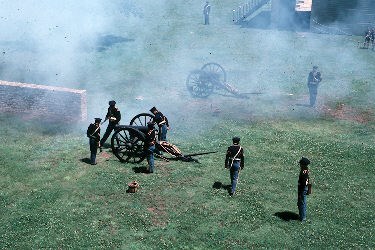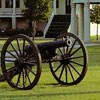
68… All guns, which are mounted, should be sponged clean and their vents examined to see that they are clear. The chassis should be traversed and left in a different position, the top carriage moved backward and forward and left alternately over the front and rear transoms of the chassis; the elevating screws or machines wiped clean, worked and oiled if required. This should be done regularly once in every week. 69… When tarpaulins, or pent houses are placed over the guns, they should be removed every other day, or three times a week, then the weather is fair, the carriages and guns brushed off, and if damp, allowed to dry. 72… At all posts with fixed batteries, the position of every gun, mounted or to be mounted, will have its number, and this number be placed on the gun when in position. 73… For every such work a post-book of record will be kept, under the direction of the commander of the post, in which will be duly entered-the number of each mounted gun, its caliber, weight, names of founder and inspector, and other marks; the description of its carriage and date of reception at the post; where from; and the greatest fields of fire of the gun, in its position. 74… Every commander of a fort or other fixed battery, will before entering on Artillery practice, carefully reconnoiter and cause to be sketched for his record-book, the water channels with their soundings, and other approaches to the work. Buoys or marks will be placed at the extreme and intermediate ranges of the guns, and these marks be numerically noted on the sketch. A buoy at every five hundred yards may suffice. 75… At the time of practice, a distinct and careful note will be made for the record-book of every shot or shell that may be thrown, designating the guns fired by their numbers, the charges of powder used, the times of flight of shots and shells, the ranges and ricochets, and the positions of guns in respect to the horizontal and vertical lines. 76… The time of flight of a shell may be noted with sufficient accuracy by a stop-watch, or by counting the beats-(previously ascertaining their value) of other watches, and the range may sometimes be computed by the time of flight. Other modes of ascertaining the range will readily occur to officers of science. 77… When charged shells with fuses are thrown, the time of bursting will be noted. If they are intended to fall on land, only a blowing charge will be given to the shells, so that they may be picked up for further use. 78… On filing from the barrel, the proof range of powder will be marked on the cartridges. 79… The general objects of this practice are-to give to officers and men the ready and effective use of batteries, to preserve on record the more important results for the benefit of the same, or future commanders, and to ascertain the efficiency of guns and carriages. 80… Commanders of field artillery will also keep registers of their practice, so that not a shell shall be thrown in the Army, for instruction, without distinct objects, such as range, accuracy of aim, number of ricochets, time of bursting, in the case of shells, &c. 81… Every company, with a field battery, will be allowed for annual practice, 200 blank cartridges, and a third of that number of shots or shells. Companies, with fixed batteries, will be allowed 100 cartridges each, with seventy-five shots or shells. This ammunition will be expended in nearly equal discharges in the three months designated, and if the company be mounted, eight blank cartridges will be allowed for each of the other months in the year. This allowance is intended only for companies permanently serving with batteries. The firing with field guns by other Artillery companies must be confined to blank cartridges. 82… For all Artillery, there will be, annually, three periods of practice in firing: --April, June, and October, for the latitude of Washington and South; and May, July, and September, North of that latitude. 83… At the termination of each period of practice, the commanding officers of posts will transmit to the Adjutant-General, all reports of the results, in order that proper tabular statements may be prepared for the information of the War Department, and the General-in-Chief. 84… To determine accuracy of aim, in firing shots and shells, butts or targets will be sought for or fixed. Where no natural butt presents itself, targets will be erected. A form for floating targets will be sent to the commanders of the several forts. 85… As practice in gunnery is a heavy expense to Government, and yet indispensable to the instruction of both officers and men, commanders of companies and their immediate superiors, are charged with the strict execution of the forgoing details; and all officers authorized to make tours of inspection will report through the prescribed channels, on such execution. 95… Commanders of infantry regiments are enjoined to avail themselves of every opportunity of instructing both officers and men in the exercise and management of field artillery; and all commanders ought to encourage, by every means, all sort of useful occupations, and manly exercises, and diversions amongst their men; and, with the same care, to repress every species of idleness, dissipation, and immorality. |
Last updated: July 30, 2016

